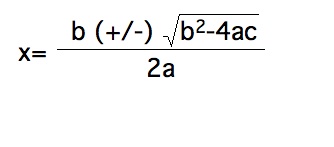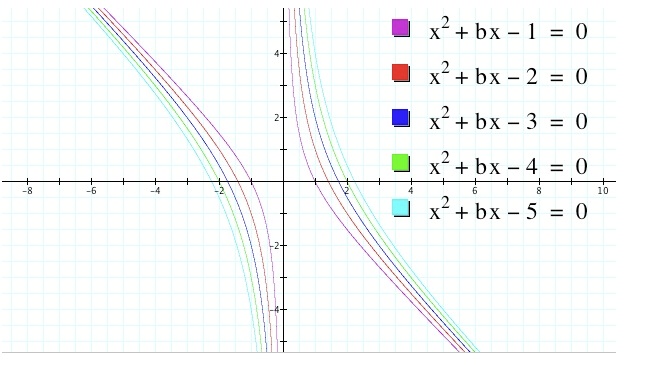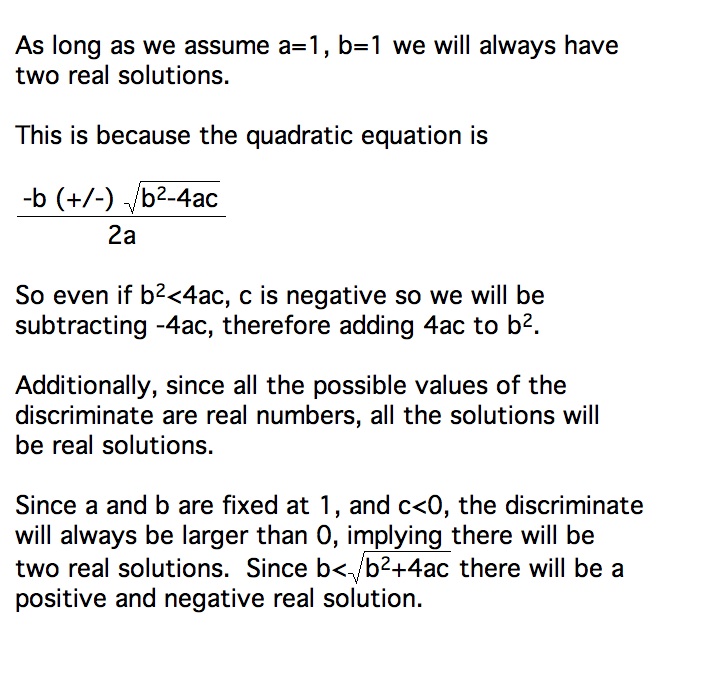

EMAT 6680
Assignment #3
Stephen J. Morgan
Prompt:

Solution:
To begin with this investigation let's first look at the graph on the xb plane. I started by looking at the graph on the xb plane with b's values varying from -5 to 5. Click here to see the animation. If you prefer, I also have the graph shown
below with values b from -3 to 3.

The graph above shows us many things. We can see that where b=3>2 that there are two real solutions for the equation. We can also see that b=2 has one negative real solution and that b=1 has no real solutions.
Additionally, the horizontial line b=-2, indicates we have one positive real solution. Now the example b=-3<-2 has two real positive solutions. Why? Well remember the standard form for a quadractic equation where a is the coefficent of the quadractic term, b is the
coefficent of the linear term, and c is the constant:

The equation we are using to investigate the xb plane has a=1 and c=1. This information in addition to our varied values of b, allows us to use these values within the quadractic equation to continue our investigation.
First let's look at when b=3>2 and a=1 and c=1. Using the quadractic equation we yield:

The roots for this equation are two real roots with approximate values of x=-0.38 and -2.62. Observe that this gives us two negative real roots as predicted earlier. These values are the values of x where x intersects with b=3 in the xb plane. Another observation worth
considering is the value of b and the discriminate. Since b>2 and a=1 and c=1, the value of the discriminant is larger than 0. This implies that there are two real solutions, and the values of a, b, and c, suggest the values will be negative.
Let's consider the quadractic equation when b=2, a=1, and c=1. This gives us:

The solution produced in the equation above is x=-1. Observe that when we made our orignial graph, the graph suggested that the intersection when b=2 would be at x=1. We can also verify this by checking the discriminate. Since the value of the discriminate is 0, there
should be only 1 real solution. Since a, b>0 we also know that the solution is negative.
Next let's see what happens when b=1, a=1, and c=1. The equation is:

We can see that the roots are complex, so there are no real solutions. We can also see that our graph from above supports this claim. Furthermore, the discriminate is negative, supporting the claim we have no real solutions.
For b=-2, a=1, and c=1 the equation we get is:

Notice here that there is one real root at x=1, which is in line with our graph. Since our discriminate is 0, it makes sense we only have 1 real root. We can once again tell from the values of a, b, and c our root will be positive.
Finally let b=-3, a=1 and c=1. This gives us:

We find here that we have two real roots at x= 0.38 and 2.62. This follows in accordance with our graph and it makes sense the roots are positive based on the values of a, b, and c. Since the discriminate is greater than 0, it also seems logical
that there are two real roots.
Before we finish let's look at the value of c. What if instead of 1 we had changed the value of c? What if c was an integer less than 0? Below is a graph for c with values of -1, -2, -3, -4, -5. If we let b=n will there always be two roots? Will one always be positive and will
the other be negative? Click on the animation, to explore.

